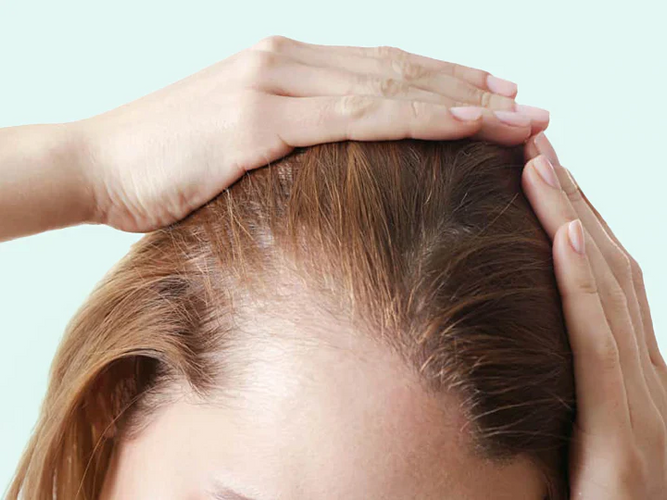Hormonal hair loss is common among women experiencing hair thinning. It’s estimated that around 50% of women will face noticeable hair loss at some point in their lives. The most frequent type is female pattern hair loss, which affects roughly one in three women.
What is hormonal hair loss?
Hormonal hair loss happens when shifts in your hormone levels cause your hair to shed. That’s because your hair follicles respond to hormonal signals. When the hormone DHT (a stronger form of testosterone) becomes more active, or when levels of the female hormones oestrogen and progesterone drop, it can lead to increased shedding and reduced hair regrowth.
Hormonal hair loss can affect both men and women, but it often appears differently. In women, the hair usually thins gradually across the whole scalp, especially along the parting and crown. In men, it more often presents as androgenetic alopecia: a hereditary form of hair loss where hormones play a key role. This typically starts with a receding hairline or thinning at the crown. This blog focuses specifically on hormonal hair loss in women.
The hair growth cycle and hormonal hair loss
To understand hair loss, we first need to look at the hair growth cycle. Hair grows and sheds in a natural rhythm. Adults typically lose between 50 and 150 hairs per day: so some hair shedding is completely normal. While some hairs are falling out, others are going through different stages of growth:
- The anagen phase is the active growth stage where new hairs grow from the follicles. Around 80 to 90% of your hair is in this phase at any given time.
- The catagen phase is a short transitional stage that lasts a few weeks.
- The telogen phase is the resting phase where the hair is no longer growing but remains in the follicle.
Hormonal hair loss can disrupt this cycle by causing more hairs to enter the shedding phase too early. The anagen (growth) phase becomes shorter, while the telogen (resting) phase lasts longer. As a result, fewer new hairs grow back, and thinning or visible hair loss may occur.
Which hormones influence hair loss?
Several hormones can affect your hair growth:
- DHT (dihydrotestosterone): This is a powerful form of testosterone. DHT attaches to receptors in the hair follicles, causing them to shrink and work less effectively. If your follicles are sensitive to DHT, this can disrupt the hair growth cycle and lead to increased hair shedding. A rise in DHT levels may be triggered by hormonal changes, such as during menopause, ongoing stress, or thyroid issues.
- Oestrogen and progesterone: These female hormones help to protect hair. When their levels drop, your hair can become more vulnerable to thinning.
- Cortisol: Known as the stress hormone. If your body is under long-term stress, cortisol levels can rise and disturb the balance of other hormones, which may affect hair growth.
- Thyroid hormones: If your thyroid is overactive or underactive, it can influence the hair growth cycle. Hair may become finer or fall out more easily.
What are common hormonal triggers for women?
Throughout a woman’s life, there are various hormonal shifts that can lead to temporary hair loss. These include:
-
Pregnancy and the post-partum period: During pregnancy, oestrogen levels are high, which supports hair growth. Many women notice their hair becomes fuller and thicker. After giving birth, oestrogen levels drop rapidly, pushing hair into the resting phase. This can lead to temporary hair shedding: but don’t worry, in most cases, it balances out over time.
-
Menopause: During menopause, the body produces less oestrogen and progesterone. This shift can cause a variety of symptoms, including the experience of thinning hair. Read more about hair loss during menopause.
-
Stopping hormonal contraception: When you stop using hormonal birth control, your body has to readjust its hormone levels. This change can disrupt the natural balance and may lead to temporary hair loss.
-
Thyroid issues: Both an overactive and underactive thyroid have been linked to changes in hair growth.
-
Chronic stress: Ongoing stress raises cortisol levels, which can interfere with other hormones and impact the hair growth cycle.
-
Lack of sleep: Poor or disrupted sleep can throw off the hormones that help your body recover and regenerate, including those affecting your hair.
-
Nutritional deficiencies: Certain nutrients are important for hormonal balance. If you're low in iron, zinc, vitamin D or B vitamins, this may affect your hair health.
-
Environmental factors: Some chemical substances found in cosmetics, such as parabens and UV filters, are known as xeno-oestrogens and may disrupt hormone function.
-
Medication or medical conditions: Some medicines, like antidepressants or hormonal contraceptives, can also influence your hormonal balance.

How can you recognise hormonal hair loss?
There are several signs and situations that may help you recognise hormonal hair loss. One common sign is gradual thinning: especially on the crown or along the parting. You might also notice your hair becoming generally thinner all over your scalp, which is known as diffuse hair loss.
Are you going through a phase in life where hormonal changes are likely? For example, during pregnancy, after stopping contraception, or during menopause? If so, this could be the reason behind your hair shedding. Other signs to watch for include mood swings, tiredness, irregular periods or changes in weight.
How is hormonal hair loss diagnosed?
A doctor can perform a blood test to check whether your hair loss may be linked to hormone levels. Common markers that may be examined include:
- Thyroid levels (TSH, T3, T4)
- Sex hormones (oestrogen, testosterone, DHEA-S)
- Iron status (ferritin)
- Vitamin D, B12 and folic acid
If you want clarity about whether your hair loss is hormone-related, it's best to consult a medical professional.
Frequently Asked Questions about hormonal hair loss
Is hormonal hair loss temporary or permanent?
That depends on the cause. After childbirth, hair loss is often temporary and regrowth happens naturally. In other cases, such as genetic sensitivity to DHT, hair thinning may continue. With the right care, you can support your hair and potentially slow down the process.
Does hormonal hair loss only affect women?
No, men can also experience hair loss due to hormonal changes. However, in women the situation is often more complex, as multiple hormones like oestrogen and progesterone are involved.
How many hairs do I lose per day on average?
Adults normally shed around 50 to 100 hairs per day. If you’re experiencing hair loss, this number can rise to over 150 hairs a day.
Conclusion
Hormonal hair loss is a common type of hair thinning, especially among women. It is closely linked to shifts in hormone levels such as DHT, oestrogen, progesterone, and thyroid hormones. These changes often occur during life stages like pregnancy, menopause or periods of prolonged stress. Recognising the pattern and understanding possible causes are important steps in managing hair loss. While hormonal hair loss isn’t always preventable, a healthy lifestyle and good hair care can help support your scalp and hair condition.
Sources
Sinclair, R. (2007). "Male pattern androgenetic alopecia." BMJ Clinical Evidence
Deloche, C. et al. (2007). "The influence of the menstrual cycle on the hair growth cycle." Dermatology
Mirmirani, P. (2011). "Hormonal changes and hair loss in women." Dermatologic Clinics
This information does not replace professional medical advice. If in doubt, always consult a doctor or specialist.













